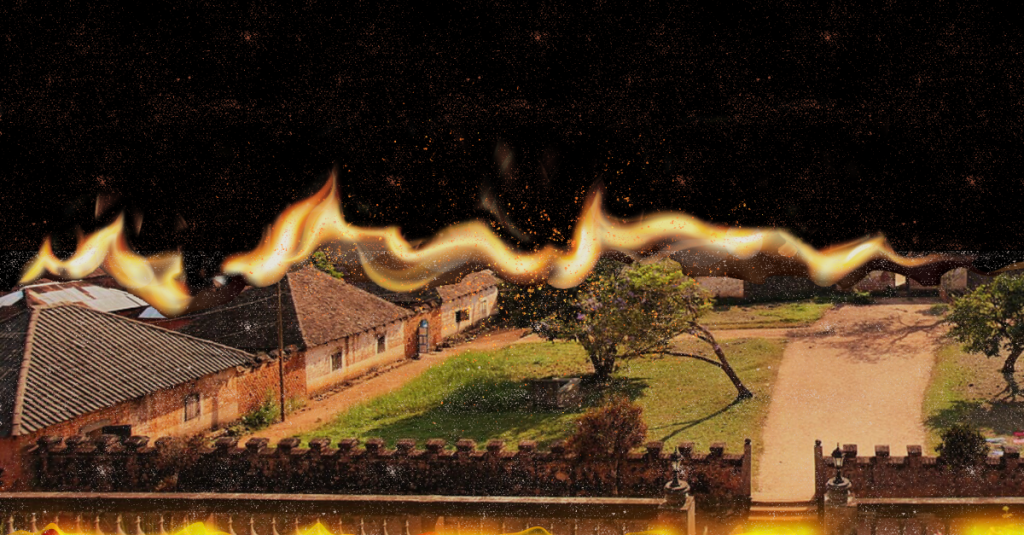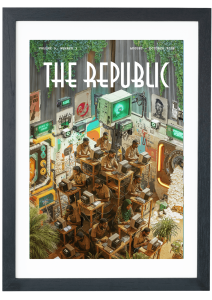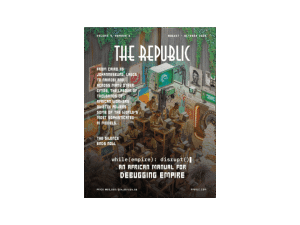
Photo Illustration by Ezinne Osueke / THE REPUBLIC. Source Ref: WIKIMEDIA.
THE MINISTRY OF CULTURAL AFFAIRS
What Burns in Bafut Is More Than a Place

Photo Illustration by Ezinne Osueke / THE REPUBLIC. Source Ref: WIKIMEDIA.
THE MINISTRY OF CULTURAL AFFAIRS
What Burns in Bafut Is More Than a Place
The Bafut Palace rises from the misty hills of North West Cameroon, a sacred site embodying centuries of cultural and historical continuity. Its intricate architecture and storied relics whisper the legacies of the Fons, hereditary rulers whose governance and spiritual leadership defined the identity of their people. Achirimbi I, one of the earliest and most venerated Fons, established the Bafut Kingdom as a bastion of tradition, resilience and authority. His grandson, Achirimbi II, famously mediated between colonial powers, safeguarding his people’s autonomy amidst the disruptive tides of British and German rule. To Cameroonians, the palace represents more than a historical landmark; it is the heart of a living culture, where rituals bind the present to the past and where governance and spirituality converge.
Yet today, the palace stands under siege, its legacy threatened by the Anglophone crisis that has engulfed the North West and South West regions of Cameroon. What was once a symbol of unity now lies at the mercy of a protracted conflict that has torn communities apart. Chieftaincy itself, an institution deeply rooted in pre-colonial African governance and identity, has been weaponized. Chiefs have become targets, accused by separatists of complicity with the central government, while traditional sites like the Bafut Palace suffer collateral destruction.
SITES OF MEMORY
The institution of chieftaincy in Cameroon is both ancient and adaptive. Chiefs, or Fons in the North West, are the custodians of tradition and mediators between the spiritual and temporal realms. They are often appointed or funded by the state, a link that has led many separatists to view them as collaborators. This perception has proven deadly. Armed separatist groups have systematically targeted chiefs, kidnapping or killing dozens. Palaces, once safe havens and archives of ritual, are now battlegrounds or abandoned ruins. A palace without its people is a drum without sound.
Palaces hold more than relics. They are spaces of community, ceremony and ancestral continuity. These sites house sacred artefacts used in funerals, enthronements, fertility rites—ceremonies where the past steps into the present. The destruction is not only architectural; it severs the community’s spiritual lineage, disrupting the intergenerational chain that anchors identity.
Political theorist, Pierre Nora, wrote that lieux de mémoire—sites of memory—arise when the living flow of tradition is broken. In Cameroon, where war and displacement have interrupted centuries-old rhythms, the palace becomes more than a building; it becomes an archive of identity. To destroy it is to fracture the grammar by which people remember who they are.
Heritage, as David Lowenthal reminds us, is not neutral—it is curated, consecrated and often political. In a country as ethnolinguistically fractionalized as Cameroon—home to over 250 languages and dozens of ethnic communities—heritage becomes a double-edged sword. It can unify or divide. It can heal or calcify wounds. As Frantz Fanon warned, a decolonized people who forget their culture risk replacing one master with another—an external oppressor with internal alienation.
shop the republic
A BATTLE OVER CULTURAL SOVEREIGNTY
The Anglophone crisis is not merely a political or territorial dispute. It is a battle over cultural sovereignty. And as palaces burn and shrines fall silent, what is at stake is not only a people’s memory—but a nation’s future. It would be a mistake to view the cultural emergency in Cameroon solely through the lens of war. The dismantling of heritage institutions began long before the first gunshots in Bamenda in 2017. Since the early years of President Paul Biya’s four-decade rule, the national emphasis on cultural preservation has steadily waned. Ministries were hollowed out. Museums shuttered. Budgets slashed. What was once a cornerstone of national development has now become an afterthought.
Contrast this with the post-independence years under President Ahmadou Ahidjo. In the 1960s and 70s, cultural policy was integral to the project of nation-building. For newly independent African states, heritage served not merely as ornament but as a strategic tool to repair colonial erasure and assert sovereign identity. In Cameroon, this took many forms: the state revived traditional festivals, invested in youth-focused holidays like the Fête de la Jeunesse and developed national radio programming under the Ministry of Information and Culture that highlighted local music, storytelling and indigenous languages—a common tactic among post-independence African governments seeking to forge unity across linguistic divides.
Cameroon’s delegation to the 1977 Second World Black and African Festival of Arts and Culture (FESTAC) in Lagos was robust and intentional, featuring dancers, musicians and scholars as cultural ambassadors. FESTAC was not just a celebration—it was a decolonial project, a pan-African counter-archive to the imperial museum. Domestically, initiatives like the Fête de la Jeunesse, regional arts festivals and state-supported archives reflected this investment in memory. Institutions such as the National Museum and the Bureau for the Promotion of Cultural Industries were empowered to not only preserve but generate cultural capital.
But the tide turned. With the economic downturn of the 1980s and the arrival of structural adjustment programs imposed by the International Monetary Fund and World Bank, Cameroon, like many African nations, was forced to gut its public sector in exchange for debt relief. Culture, deemed non-essential, was the first to go. The Bretton Woods consensus had no metric for oral history or spiritual continuity. In its calculus, culture could not be monetized—and so it withered.
shop the republic
shop the republic
shop the republic
-
‘The Empire Hacks Back’ by Olalekan Jeyifous by Olalekan Jeyifous
₦70,000.00 – ₦75,000.00Price range: ₦70,000.00 through ₦75,000.00 This product has multiple variants. The options may be chosen on the product page -
‘Make the World Burn Again’ by Edel Rodriguez by Edel Rodriguez
₦70,000.00 – ₦75,000.00Price range: ₦70,000.00 through ₦75,000.00 This product has multiple variants. The options may be chosen on the product page -
‘Nigerian Theatre’ Print by Shalom Ojo
₦150,000.00 -
‘Natural Synthesis’ Print by Diana Ejaita
₦70,000.00 – ₦75,000.00Price range: ₦70,000.00 through ₦75,000.00 This product has multiple variants. The options may be chosen on the product page
CULTURAL HERITAGE AS A CASUALITY OF WAR
The Bafut Palace’s plight is emblematic of the broader devastation sweeping through Cameroon’s cultural landscape. Sacred groves, once sanctuaries of ritual, have been bulldozed for military installations. Entire archives—oral histories, artefacts and architectural marvels—have been incinerated in raids. Craft traditions that embody centuries of artistic ingenuity, such as Bamenda’s beadwork, are vanishing as artisans flee the violence. The palace itself, listed as a UNESCO Tentative Site, has been damaged in skirmishes, its centuries-old relics endangered by neglect and conflict.
This pattern of cultural destruction is not unique to Cameroon. Across Africa, heritage sites have been systematically targeted by armed groups and state actors alike. The destruction of Timbuktu’s mausoleums by Islamist extremists in Mali, the looting of Ethiopian artefacts during the Tigray conflict, and the attacks on Nigeria’s cultural sites by Boko Haram all point to a disturbing trend: cultural heritage is often one of the first casualties of war. Yet, these acts rarely spark the same level of global outrage as similar attacks in the Middle East or Europe. This silence is not incidental. It reflects a global hierarchy of grief, in which African ruins rarely register as civilizational losses.
In the absence of state support, Cameroon’s diaspora has stepped in to fill the void. In cities like Washington, D.C., London and Paris, diasporic organizations such as Mboa Paris are raising awareness about the urgency of heritage preservation in Cameroon—educating communities abroad while mobilizing financial and moral support for cultural initiatives back home. In Foumban, home to one of Cameroon’s most architecturally and historically significant palaces, the Sultan has actively appealed to the diaspora for support, seeking partnerships to restore the palace grounds and protect the Bamoun cultural legacy from erasure. While remittance economies are fragile, they are vital in creating a kind of ‘shadow archive’ of Cameroon’s heritage abroad and seeding funding for projects back home. Yet without institutional infrastructure, these efforts remain precarious—dependent on the labour and liquidity of overextended volunteers.
Beyond material reconstruction, some groups are turning to technology to safeguard cultural knowledge. Digital archiving initiatives, 3D scanning of artefacts, and oral history projects are emerging as tools to document what might otherwise be lost. This mirrors similar efforts seen in other African conflicts, where organizations like CyArk have worked to digitally preserve endangered heritage sites. These projects ensure that even if physical structures are destroyed, their cultural significance can endure in some form.
The stakes could not be higher. As political instability continues, the loss of Cameroon’s cultural heritage threatens to fracture national identity. Each destroyed site weakens the collective memory that binds communities, creating a void where cultural understanding and unity once flourished. For the young generation—those inheriting this scarred landscape—the absence of these cultural anchors portends a future marked by dislocation and loss. As elders pass away in exile and ceremonies go unperformed, memory is displaced alongside people.
Cameroon is often described as ‘Africa in miniature’—a nod to its geographic, linguistic and cultural diversity. But what does that mean when the miniature is broken, when the mosaic has no grout to hold it together?
To neglect heritage in times of peace is negligent. To abandon it in times of war is catastrophic. Cultural memory is not peripheral to nationhood—it is its very scaffold. The destruction of a palace is not just a loss for a village. It is a tremor in the bedrock of national coherence. If Cameroon is to imagine a shared future after this conflict, it must begin by remembering. Not just in textbooks or commemorative days, but through living practices, restored sanctuaries and re-empowered custodians of tradition. Heritage must no longer be seen as ornamental, but as infrastructural.
What burns in Bafut is not only timber and thatch, it is a thousand-year archive of who we are, and what we might still become⎈
BUY THE MAGAZINE AND/OR THE COVER
-
‘Make the World Burn Again’ by Edel Rodriguez by Edel Rodriguez
₦70,000.00 – ₦75,000.00Price range: ₦70,000.00 through ₦75,000.00 This product has multiple variants. The options may be chosen on the product page -
The Republic V9, N2 Who Dey Fear Donald Trump? / Africa In The Era Of Multipolarity
₦40,000.00
















